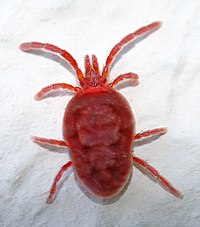
Photo from wikipedia
Predation is a biotic interaction that links water mites to different taxonomic groups of benthic invertebrates. Diptera larvae (Chironomidae) and microcrustaceans (Cladocera, Copepoda, Ostracoda) are known to be the most… Click to show full abstract
Predation is a biotic interaction that links water mites to different taxonomic groups of benthic invertebrates. Diptera larvae (Chironomidae) and microcrustaceans (Cladocera, Copepoda, Ostracoda) are known to be the most commonly preferred prey by water mites. Although these predatory interactions are known from observations and ex situ investigations, the distribution patterns and co-occurrence of water mites and their prey in littoral lentic habitats have been poorly studied. Our goal was to determine whether predation might serve as a significant factor in water mite assemblage composition and distribution. Samples were taken from littoral zones of 21 artificial lakes (reservoirs) in the Dinaric Western Balkan ecoregion of Croatia. At every site, 10 samples were collected with regard to shore slope in depth zones of up to 1 m. In total 490 samples were collected from April 2016 to July 2017. Data analysis showed that the spatial distribution of water mites was partially correlated with the environmental parameters we measured (explaining 45.1% of total water mite variation). A positive correlation between water mite abundance and diversity and depth gradient (favouring more stable conditions in deeper parts of the littoral zone) was also observed. Finally, water mite abundance and species richness variation were found to be best predicted by the abundance of potential prey groups. Predation was statistically determined to be a strong dispersion variable, most probably influencing both spatial distribution and composition of water mite assemblages.
Journal Title: Experimental and Applied Acarology
Year Published: 2019
Link to full text (if available)
Share on Social Media: Sign Up to like & get
recommendations!